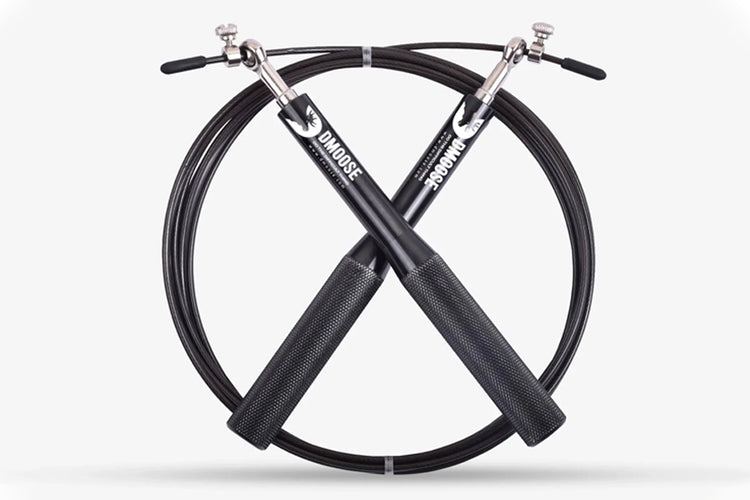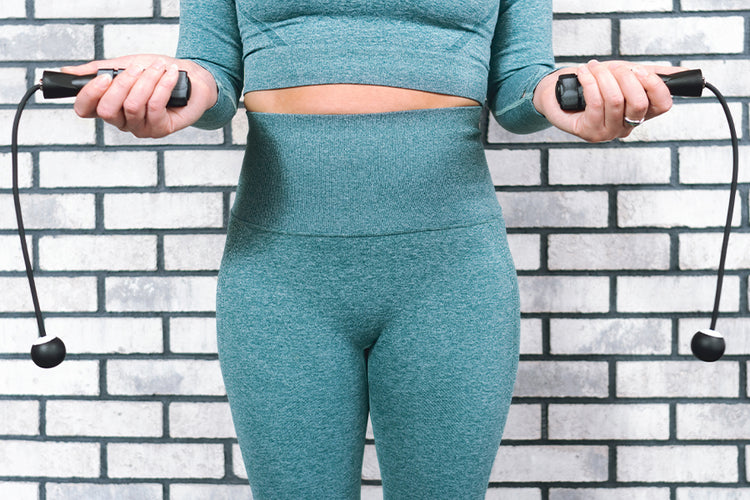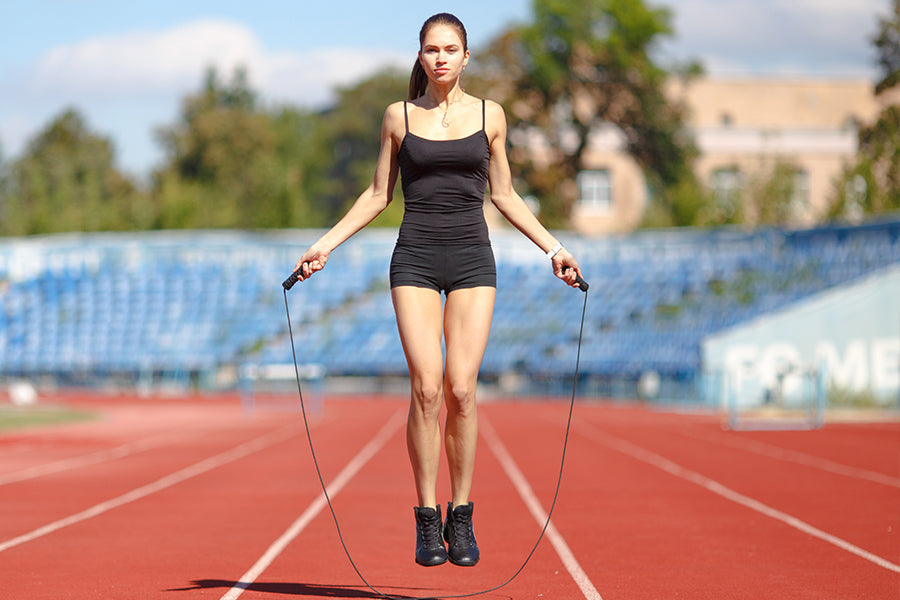I remember trying to jump rope with my friends on the playground as a kid. I was always the one who struggled to keep up, tripping over the rope and feeling frustrated.
It wasn't until I got older and discovered the benefits of jumping rope for fitness that I realized my struggles may have been due to using the wrong size rope all those years ago.
If only I had known then what I know now about measuring jump rope size. So, if you want to start or improve your jump rope game, let me share some easy steps to find the right fit for your jump rope.
Related Article: 6 Best Jump Rope Exercises to Burn Fat Fast, Experts Say
Why Does Jump Rope Length Matter?
Understanding the significance of jump rope length is crucial before learning how to measure it correctly. Jumping rope is a skill-building workout that requires you to learn the basics before advancing to more challenging techniques.
Therefore, having the appropriate rope length is vital to develop the necessary mechanics and positioning to progress to more complex jump rope movements.
An unsuitable rope length can have detrimental effects on your performance. For instance, a too-long rope will repeatedly hit the ground, making it difficult to maintain momentum, keep up with the rhythm, and maintain proper arm positioning, resulting in poor mechanics.
In contrast, a too-short rope will force you to jump higher than optimal, making you prone to tripping and hitting your feet.
Types of Jump Ropes
Selecting an appropriate jump rope and customizing its length to fit your height is crucial for a productive jump rope exercise. Various types of jump ropes are available, and it's essential to determine the suitable rope and length that suits your body. Below, we'll discuss the different jump rope options and how to determine the ideal rope length for you.
Speed Ropes
Speed ropes are designed for quick and high-speed jumping and are considered the sprint workout of jump ropes. They are typically made with lightweight materials and feature a thin cord and ball bearings in the handles to allow for rapid spinning.
Advanced jumpers, particularly those in CrossFit training, often use speed ropes to perform complex moves such as double-unders and criss-crosses. Adjusting the length of a speed rope is a straightforward process.
Most speed ropes have a holding screw in the handles that can be loosened to adjust the length to your liking. Once you have determined the appropriate length, wire cutters can trim any excess length.
Knitted Jump Ropes
When discussing knitted jump ropes, we often think of the classic double-dutch ropes we use on the playground. However, nowadays, knitted ropes are specifically designed for sports, and although they are robust, they are relatively lightweight.
Beaded jump ropes can also be categorized as knitted ropes since they have a knitted rope underneath the beads, even though the focus is on the beads themselves.
Adjusting the length of a knitted jump rope is a simple process. You can adjust the length by pulling the rope through the handle and tying a knot where it measures up to your sternum. It's advisable to test the length a few times before cutting off any excess rope.
PVC Jump Ropes

PVC jump ropes are ideal for beginners as they are lighter than weighted ropes but heavier than speed ropes.
Adjusting the length of a PVC jump rope is a straightforward process. Most brands incorporate a plastic clip inside the handle, which can be released to adjust the length to your preference. Once you have determined the appropriate length, you can trim any excess rope with scissors.
However, it is advisable to test the length for a few workouts before cutting it to ensure it is short enough. A helpful tip is to avoid cutting the rope too quickly, as it can end up being too short, which happened to me when I cut my jump rope right after measuring it.
Weighted Jump Ropes
Got a new weighted jump rope and put 1,000,000 jumps in the books for 2020🙏🏻 pic.twitter.com/JLgVvLD7Oq
— Daryl Evans (@DarylEvans15) September 19, 2020
Use a weighted jump rope to intensify your jump rope workout. These ropes have additional weight in the handles, typically 1 to 6 pounds, which can give your shoulders and arms an extra workout while jumping. Unlike speed ropes, weighted ropes are slower, allowing you to concentrate on your form and coordination.
Weighted ropes, such as the Crossrope, cannot be trimmed. Therefore, you must rely on the rope's design to select the appropriate length based on your height. If you fall between two sizes, choosing the larger size is recommended. You can shorten the rope by tying a knot near the handle if the rope is too long.
Related Article: Weighted Jump Rope Benefits and Why You Should Add It to Your Workout
Cordless Jump Ropes

A jump rope that doesn't have a cord to trip over is called a cordless jump rope. It's ideal for those with limited space or low ceilings. The handles of a cordless jump rope are weighted, which allows you to concentrate on your speed and effort instead of worrying about tripping over a rope.
If you need to fix the length of your cordless jump rope, there is no need to cut it. You can simply pull the excess length into the handles to shorten the cords. And if you need to lengthen it, you can pull the cords out of the handle. It's a straightforward process. With a cordless jump rope, there's no risk of it being too long or too short.
How Long Should a Jump Rope Be?
To keep it straightforward, your jump rope's length should be around three feet longer than your height. For instance, if you are 5 feet and 8 inches tall, your jump rope should be approximately 8 feet and 8 inches long, plus or minus.
As you become more adept and efficient in skipping rope, you should shorten the length by an additional six inches. Some jump ropes can be adjusted once, while others can be adjusted multiple times.
If you intend to switch between freestyle skipping and speed rope or plan to share your jump rope with others, a rope with available adjustments might be a better choice.
Benefits of a Properly Sized Rope
Properly sized ropes provide extended benefits for mental and physical purposes for the performers. Given the importance of properly sizing your jump rope, let's briefly discuss the advantages of doing so.
Prevents Injury Risk
Having a jump rope appropriate for your height can help minimize the risk of injuries commonly associated with jumping rope. When you use a jump rope that is too short or too long, you may not be able to maintain the correct form, which can cause you to trip over the rope, fall, and hurt yourself.
However, with an appropriately sized jump rope, you can develop the correct mechanics and avoid tripping, reducing the risk of injury. This is particularly important for beginners training, who may be more prone to injuries due to a lack of experience and coordination. You can also add Post Workout Supplements to your diet to prevent the risks of injury and recover steadily.
By reducing the risk of injury, you can feel more confident and comfortable while jumping rope, thoroughly enjoying the benefits of this fun and effective exercise.
Improves Posture
Developing good posture is essential to maximize the many benefits of jump rope exercises. Proper posture includes keeping your back straight, shoulder blades pulled back, and eyes looking forward. Using a jump rope that is appropriately sized for your height ensures that your posture is correct during your workout routine.
If your jump rope is too short or long, it can cause you to hunch over or lean too far back, leading to bad habits and potential injuries. Therefore, using an appropriately sized jump rope can help you maintain the correct posture, prevent injuries, and ensure that you get the most out of your workout.
Related Article: What Muscles Do Battle Ropes Work? Exercise Explained
Shortens Your Learning Curve
Learning to jump rope efficiently and effectively can be challenging, especially for beginners. One common mistake that novice jumpers make is using inefficient motion, which can result in wasted energy and slow progress. Using an adequately sized jump rope to your body can reduce the learning curve and avoid many common mistakes.
This can help you to master the fundamental techniques of jumping rope more quickly and efficiently, allowing you to progress towards more advanced techniques and workouts in less time.
Saves You Money
Choosing the correct jump rope size can be a cost-effective decision. Investing in a high-quality jump rope that is the correct length for you can extend its lifespan significantly. If the rope is of inadequate size, it can lead to premature wear and tear. This may cost you more money in the long run as you'll need to replace the jump rope sooner than anticipated.
Improves Mind-Body Coordination
When using a jump rope that is the correct size for your height, you can improve your mind-body coordination as it helps you achieve a better flow state. Tripping frequently due to an ill-fitting rope can be frustrating and hinder your progress in learning more advanced jump rope tricks and techniques.
You can take Omega 3 Fish Oil Supplements to enhance your brain and heart function and enjoy great benefits.
A correctly sized rope allows you to focus and avoid unnecessary distractions, helping you to achieve an ideal mind-body connection.
Related Article: Jump Rope for Mental Health: 5 Ways Jump Rope May Improve Mental Health
How to Measure Jump Rope Size: Chart by Height
Jumping rope is a great workout, but having the right size jump rope is essential to ensure proper form and technique. Here's a chart that outlines how to measure your jump rope based on your height.
|
Height Jump |
Rope Length |
|
4'6" to 4'9" |
7'4" to 8'0" |
|
4'10" to 5'3" |
8'0" to 8'6" |
|
5'4" to 5'7" |
8'6" to 9'0" |
|
5'8" to 5'10" |
9'0" to 9'6" |
|
5'11" to 6'1" |
9'6" to 10'0" |
|
6'2"to 6'4" |
10'0" to 10'6" |
|
6'5" or taller |
10'6" to 11'0" |
- Stand up straight with your feet together and arms extended to the sides.
- Hold the jump rope handles in each hand, with the rope resting on the floor.
- Pull the rope taut to be straight and parallel to the floor.
- Place one foot in the middle of the rope and bring the handles up towards your armpits, keeping the rope taut.
- The handles should reach just below your armpits, with the rope touching the floor.
- Take note of the length of the rope from end to end, including the handles.
How to Measure Jump Rope Length
You must adjust its length to ensure your jump rope fits you perfectly. Having a jump rope that's too long or too short can lead to poor posture, injuries, and frustration. Here are five simple steps to measure and adjust your jump rope:
- Stand in the middle of the rope with one foot and bring your feet together.
- Pull the rope's end tight and point the top of the handles towards your chest.
- Bring the handles together and check where the cable ends (not the top of the handles).
- The cable should stop at your sternum or armpits. If it's too short, you'll need a longer rope. If it's too long, move on to step 5.
- Trim the excess rope using wire cutters for cable ropes or scissors for PVC ropes. Be careful not to cut too much at once. It's better to leave extra length and repeat the process if necessary.
It's important to note that different types of jump ropes may require different adjustments to achieve the ideal length. We've provided instructions on adjusting the length for four types of jump ropes to help you get started.
Final Words
Measuring and adjusting your jump rope to the correct length is essential for a successful, injury-free workout. An appropriately sized jump rope will help you develop the correct mechanics, improve your posture, shorten your learning curve, and enhance your mind-body coordination.
Additionally, having a jump rope that fits your height will save you money and frustration in the long run.
Follow the steps outlined in the measurement chart to ensure that you have the perfect length for your jump rope, and remember to adjust it as needed depending on the type of rope you're using. With a well-fitted jump rope, you can achieve your fitness goals more quickly and efficiently.
Reading List
Article Sources
- Ozer, D., et al. "The Effects of Rope or Weighted Rope Jump Training on Strength, Coordination and Proprioception in Adolescent Female Volleyball Players." The Journal of Sports Medicine and Physical Fitness, vol. 51, no. 2, June 2011, pp. 211-19.
- Chen, Chao-Fu, and Hui-Ju Wu. "The Effect of an 8-Week Rope Skipping Intervention on Standing Long Jump Performance". International Journal of Environmental Research and Public Health, vol. 19, no. 14, July 2022, p. 8472. PubMed Central, https://doi.org/10.3390/ijerph19148472.
- Yang, Xiaofeng, et al. "Physical Fitness Promotion among Adolescents: Effects of a Jump Rope-Based Physical Activity Afterschool Program". Children, vol. 7, no. 8, Aug. 2020, p. 95. PubMed Central, https://doi.org/10.3390/children7080095.











